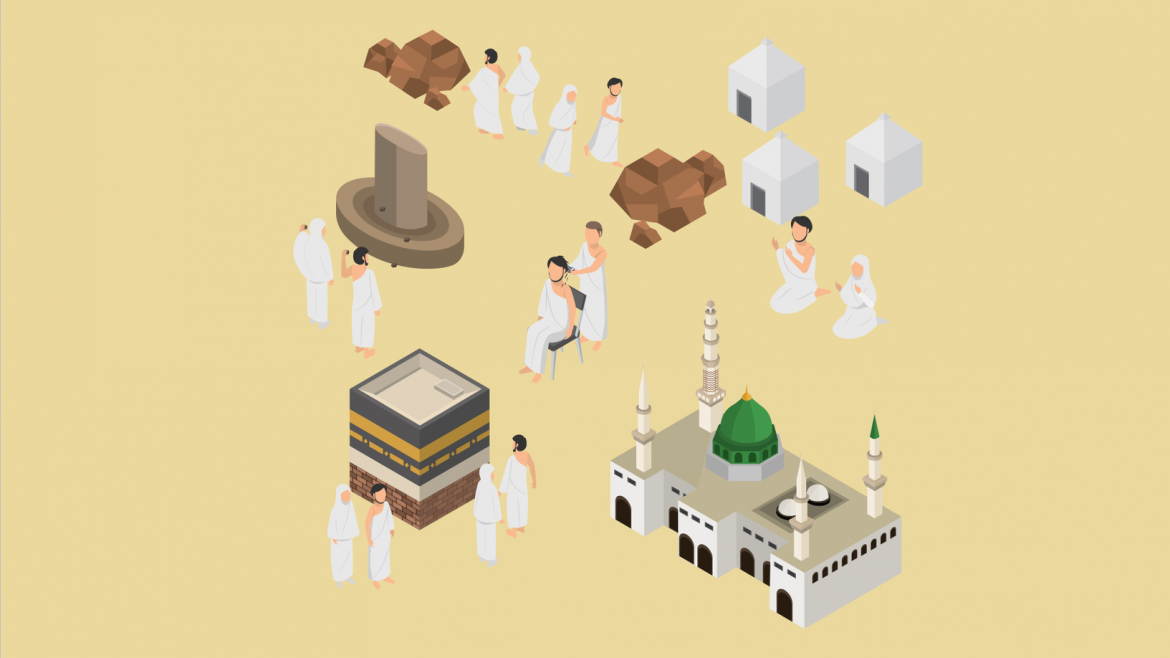The month of Hajj is approaching and Muslims around the world have started to travel to Saudi Arabia to perform the Annual pilgrimage, Hajj. Those who have physical and financial ability to perform Hajj, it is obligatory for them to perform Hajj. This article is a simple guide to perform Hajj.
It is believed that the Hajj is a journey of the body and the soul. Hajj starts on the 8th day of Zil Hijjah. There are ten basic rituals that should be performed before and during the hajj.
01. Ihram
Any pilgrim wishing to perform Hajj should take a proper bath and wear Ihram. Entering an Ihram is the very first step for Hajj. For men, Ihram is an unstitched white garment while for women it is her normal stitched clothes that cover her body and also a head covering.

After entering the state of ihram, one is not allowed to cut nails or hairs, use perfumes or any other fragrance or sacrifice animals. Pilgrims have to recite this intentionally to enter the state of Ihram. Ignoring it does not entail any consequences, but a pilgrim misses a great virtue.
02. Entering Makkah
After entering the state of Ihram, the pilgrim should move towards Makkah. Make sure you wear Ihram and make a niyyah to perform Hajj before crossing Miqat.
03. Tawaf al Qudum
Upon the arrival to Makkah, pilgrims should make a Tawaf as it is an integral part of the pilgrimage. People who are living in the boundaries of Miqat are not required to perform Tawaf al Qudum e.g. people of Jeddah.
04. Saee
Saee is described to traverse the distance between the two hills. The Safa and the Marwa. This is the second basic part of the Hajj. People who are living in the boundaries of Miqat are not required to perform Saee prior to Hajj e.g. people of Jeddah.

05. Departure Mina
On the 8th of Dhul Hijjah, all Hajj pilgrims depart to Mina, the tent city. The first day of Hajj is also called a day of Tarwiah. Mina is roughly eight kilometers away from Makkah.
Pilgrims have to stay in Mina until the sunrise of the second day of Hajj after which they leave for Arafat and pay another trip to Mina on the third day of Hajj to perform the sixth rite of the Hajj which is stoning the devil.
06. Planes of Arafat
After the dawn prayer in Mina on the 9th of Dhul Hijjah, pilgrims start their journey to the desert planes of Arafat. This is an important day of Hajj. Muslim spend the day of Arafat in the surrounding area of the Mount Arafat praying to Allah and repenting for their sins.
07. Muzdallifah
After spending a day at Arafat Muslims move to the open land of Muzdallifah which is in the Southeast of Mina. People gather there to pray Maghrib and Isha together and to spend a night collecting the pebbles. After offering the Salah of Fajr, they move back to their camps in Mina.
08. Jamarat
After coming back to their camps on the 10th of Dhul Hijja, pilgrims perform Rami at Jamarat. Rami at Jamarat is the symbolic stoning of the devil which is marked on the third day of Hajj. Pilgrims fling pebbles on the Jamarat the three walls in the city of Mina.
09.Eid Ul Adha
The pilgrims slaughter animals to mark Prophet Ibrahim’s willingness to sacrifice his son Ismael on the command of Allah. After the Rami at Jamarat and slaughtering an animal, the pilgrims are required to shave their head. They open their Ihram after shaving their head.

10. Tawaf e Ziyara
Pilgrims are required to spend three days in Mina stoning the devil and they open their Ihram after performing Tawaf e Ziyara.
Source: Life in Saudi Arabia






